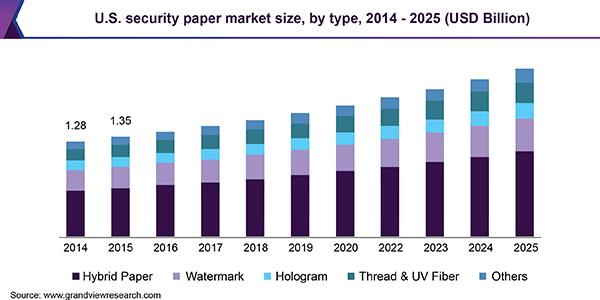Security printing includes printing of items that need authentications such as postage stamps, banknotes, identity cards, passport, stock certificates, etc. It mainly includes intaglio printing, holograms, watermarks, special paper, anti-copying marks, micro-printing, magnetic inks, serial numbers, and security threads. Security printing is mostly done to prevent illegal activities such as forgery, tampering, and counterfeiting. Several computer systems depend on some extent on the packaging, seals, and secure printing to assure significant characteristics of their protection.
Several software products get safety against forgery with the help of various techniques such as holographic stickers that are expected to tear when separated from the package. Thus, the execution of security measures is essential to guarantee the customer that the product has not tampered with after exiting the factory.
Presently, there are several techniques used to protect high-value documents, which have become available to commercial printers making them prone to forging due to use of flexographic presses and traditional offset or newer digital platforms. In addition, businesses are trying to protect their documents such as coupons, prescription pads, and transcription by including features that would ensure that they cannot be faked or that the modifications do not go undetected. Several technical methods are used in the security printing market that is frequently done on security paper.
As per the report by Grand View Research, Inc., the security paper market is poised to rise to a valuation of USD 24.33 billion and is anticipated to expand at a CAGR of 7.0% by 2025, with the Asia Pacific occupying the major market share. It is driven by a high preference for cash transactions, increasing population, and numerous government initiatives aimed at fast growth of the BFSI organization.

Top 10 Methods Of Security Printing
-
Special Papers/Substrate
Heavyweight stock papers are used for printing of bank check. The substrate of most of the banknotes is made of paper, mostly always from cotton fibers for durability and strength. In some cases, distinctly colored linen and forensic fibers are used that help against counterfeiting.
-
Watermarks
A watermark is a recognizing pattern or image in a paper that appears in several shades of light and dark colors. Watermarks are mainly used on currencies and other vital documents to prevent counterfeiting and copying. There are two types of watermarks True watermarks and simulated watermarks.
- True watermarks: A true watermark is an identifiable pattern or image on paper that looks darker than adjacent paper when observed with a light from behind the paper, owing to paper density differences.
- Simulated watermarks: Simulated watermarks are printed with white ink; they have a diverse reflectance than the base paper and can be seen only at an angle. Since the ink is white, it cannot be scanned or photocopied.
-
Intaglio Printing
Intaglio is a technique in which the image is incised into a surface. Usually, zinc or copper plates are used and the cuts are created by engraving or etching the image, but one may also use mezzotint. In intaglio printing, the surface is covered in ink and then scrubbed strongly with newspaper or tarlatan cloth to remove the ink from the surface, leaving it in the cuts.
-
Micro-Printing
They are mainly used in currency and usually shows the highest quality since it demands the maximum level of forging deterrence. The text is usually small enough to be invisible to the naked eye.
-
Holograms
The image made from holography is termed as a hologram. Holography is a photographic method that records the light dispersed from a point and then presents it in a way that looks three-dimensional. Holograms help curtail forging and replication of products hence are very vital for security purposes.
-
Security Thread
A security thread is a safety feature of numerous banknotes to defend against forging. It involves a thin ribbon that is threaded through the note’s paper.
-
Serial Numbers
Serial numbers help make real documents simpler to audit and track, and also help detect fakes. In banknote printing, unique serial number offers effective means for verification and monitoring of the production volume.
-
Anti-Copy Marks
Anti-copying marks are the design or marks on the portion of the paper that are used to produce banknotes and cheques.
-
Electronic Devices
With the start of Radio Frequency Identification (RFID), it is possible to insert very small RF-active devices into the printing of products to improve document safety. Biometric passports comprise data for the authentication of an individual’s face or fingerprint at automatic border control gates.
-
Latent Images
These are hot-stamped or pressure-sensitive labels categorized with a normal (colored or gray) appearance. When observed via a filter (such as a polarizer) an additional, typically latent, image is seen.
Features of Security Printing
Expansion of the market requires better security features and RFID tags could be the next big thing ensuring the safety of bonds and shares. A single part of paper could give access to a share that might cost a major amount of money, making these papers prone to forgery. RFID has numerous ways to improve the security of the end product and a decent value for the manufacturing of RFID could save a lot of inconvenience and trouble in the future.
The emerging trend in the security printing is that the market will see a growth in security management. Security of printed documents is a huge concern for small and medium-sized businesses who are still dependent on paper. This opens up many doors for secured paper printing and RFID installation in future documents.
Company Bio:

Grand View Research Inc. is a U.S. based market research and consulting company, registered in the State of California and headquartered in San Francisco. The company provides syndicated research reports, customized research reports, and consulting services. To help clients make informed business decisions, we offer market intelligence studies ensuring relevant and fact-based research across a range of industries, from technology to chemicals, materials, and healthcare.